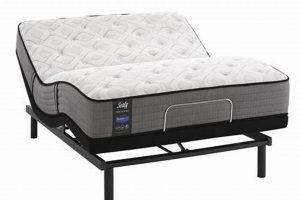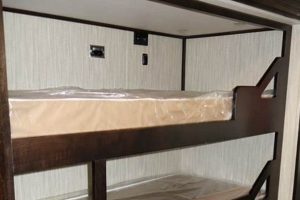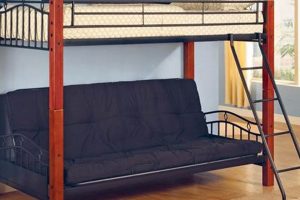A sleeping arrangement consisting of a mattress placed directly on the floor, without a bed frame or box spring, provides a minimalist approach to furnishing a sleeping space. This setup can range from a simple futon mattress positioned for nightly use to a more elaborate foam mattress intended for long-term sleep support. Considerations for ventilation and cleanliness are important when utilizing this type of sleeping surface.
The advantage of this bedding style lies in its affordability, space-saving nature, and ease of mobility. Historically, placing bedding directly on the floor has been a common practice in various cultures for centuries, often dictated by resource availability or nomadic lifestyles. Contemporary benefits include a lower profile, creating a sense of spaciousness in smaller rooms, and a potentially firmer sleep surface compared to traditional bed setups. This setup can also offer a practical temporary sleeping solution for guests.
Understanding the suitability of a mattress placed directly on the floor requires careful examination of various mattress types, proper floor preparation techniques, and strategies for maintaining optimal hygiene. Factors such as room humidity, mattress material, and personal comfort preferences play crucial roles in determining the overall effectiveness and longevity of this sleeping arrangement.
Essential Considerations for Mattress Placement Directly on the Floor
Implementing a mattress without a supporting frame requires careful consideration to ensure comfort, hygiene, and longevity. The following tips address critical aspects of this sleeping arrangement.
Tip 1: Prioritize Adequate Ventilation: Moisture accumulation beneath a mattress placed directly on the floor can lead to mold and mildew growth. Regularly lifting the mattress to allow air circulation is essential. Consider using a breathable underlayment to further enhance airflow.
Tip 2: Select the Appropriate Mattress Type: Some mattress types are better suited for floor placement than others. Foam mattresses, for instance, benefit from a solid surface to provide adequate support. Innerspring mattresses may be more prone to damage from direct floor contact.
Tip 3: Maintain a Clean Floor Surface: Regularly clean the floor beneath the mattress to minimize dust, dirt, and allergens. Vacuuming or mopping the area prior to placing the mattress back down contributes to a healthier sleep environment.
Tip 4: Utilize a Protective Barrier: Employ a moisture-resistant barrier between the mattress and the floor. This layer helps prevent moisture from seeping into the mattress and protects the floor from potential damage.
Tip 5: Consider Room Humidity: High humidity levels exacerbate moisture-related issues. Dehumidifiers can help regulate humidity and mitigate the risk of mold growth beneath the mattress.
Tip 6: Rotate the Mattress Regularly: Rotating the mattress on a consistent schedule helps distribute weight evenly and prevent premature wear and tear, extending the lifespan of the mattress.
Tip 7: Evaluate Floor Material: Hard surfaces like tile or wood are generally more suitable for direct mattress placement than carpet. Carpet can trap moisture and harbor allergens, increasing the risk of mold and mildew.
Adhering to these recommendations promotes a cleaner, more comfortable, and more durable sleep setup. Careful planning and maintenance are crucial when foregoing a traditional bed frame.
The subsequent sections delve deeper into the specifics of mattress selection and maintenance strategies for optimal performance in a floor-based setting.
1. Ventilation
Ventilation is a critical factor in the successful implementation of a floor mattress bed. The absence of a bed frame restricts airflow, increasing the potential for moisture accumulation beneath the mattress. This can lead to a range of adverse consequences, necessitating a thorough understanding of ventilation strategies.
- Moisture Accumulation and Mold Growth
The primary concern arising from inadequate ventilation is moisture entrapment. Perspiration, humidity, and spills can seep into the mattress and, without sufficient airflow, create an environment conducive to mold and mildew growth. Mold spores can trigger allergic reactions and respiratory problems, impacting sleep quality and overall health. Regular inspection and proactive ventilation are essential preventative measures.
- Mattress Material Impact
The material composition of the mattress influences its breathability. Natural materials, such as cotton and latex, generally offer better airflow than synthetic materials like memory foam. However, even with breathable materials, direct contact with the floor impedes air circulation. Selecting a mattress with inherent breathability is a crucial first step, but supplementary ventilation methods remain necessary.
- Floor Surface Considerations
The type of flooring upon which the mattress rests also affects ventilation. Porous surfaces, such as carpet, trap moisture more readily than non-porous surfaces like hardwood or tile. Carpet can also harbor dust mites and allergens, exacerbating respiratory issues. Utilizing a barrier between the mattress and carpet can mitigate these effects, but optimized ventilation practices remain paramount.
- Effective Ventilation Strategies
Several strategies can enhance ventilation beneath a floor mattress. Regularly lifting the mattress to allow air circulation is a simple yet effective method. Employing a slatted platform or a breathable underlayment provides a physical gap between the mattress and the floor, promoting airflow. Dehumidifiers can reduce ambient humidity levels, minimizing moisture accumulation. Consistent implementation of these strategies is vital for maintaining a healthy sleep environment.
In conclusion, ventilation is not merely an optional consideration but a fundamental requirement for a successful floor mattress bed arrangement. Neglecting this aspect can lead to significant hygiene and health concerns. A proactive approach involving careful mattress selection, floor surface evaluation, and consistent ventilation practices is essential for ensuring a comfortable and healthy sleep experience.
2. Support
The element of support is fundamental to the efficacy of a floor mattress bed. Unlike traditional bed setups with box springs or slatted frames, a mattress placed directly on the floor relies solely on its inherent construction to provide adequate support for the sleeper. Insufficient support can lead to spinal misalignment, pressure point discomfort, and long-term musculoskeletal issues. Consequently, the selection of a mattress with appropriate firmness and internal structure becomes paramount.
Mattress type directly influences the level of support offe
red. For instance, a thin foam mattress may lack the structural integrity required for heavier individuals, resulting in sagging and inadequate spinal support. In contrast, a hybrid mattress with a combination of coils and foam layers can provide a more resilient and contouring support system, distributing weight evenly and reducing pressure points. Individuals considering a floor mattress bed should carefully evaluate the mattress’s construction, paying particular attention to its firmness rating, coil gauge (if applicable), and foam density. Real-life examples include individuals with back pain finding relief by switching to a firmer, supportive mattress on the floor, or conversely, experiencing exacerbated discomfort when using a too-soft mattress lacking adequate support. The practical significance of understanding this connection lies in preventing chronic pain and promoting healthy sleep posture.
In summary, the support offered by a mattress used directly on the floor is a critical determinant of comfort, spinal health, and overall sleep quality. Careful consideration of mattress type, firmness, and internal construction is essential to ensure adequate support. Neglecting this aspect can lead to discomfort, pain, and potential long-term health consequences. Choosing a mattress that provides sufficient support tailored to individual needs is vital for a successful floor mattress bed arrangement.
3. Hygiene
Maintaining optimal hygiene is of paramount importance when utilizing a mattress directly on the floor. The proximity to the floor increases exposure to dust, allergens, and potential moisture, demanding stringent cleaning and maintenance practices to mitigate associated health risks.
- Dust and Allergen Accumulation
Floor surfaces naturally collect dust, dirt, and allergens, which can readily transfer to a mattress placed directly upon them. Dust mites, pet dander, and mold spores can accumulate within the mattress fibers, triggering allergic reactions and respiratory issues. Regular vacuuming of both the floor and the mattress is essential to minimize allergen load.
- Moisture Management and Mold Prevention
The absence of a bed frame restricts airflow, increasing the risk of moisture entrapment beneath the mattress. Perspiration, spills, and ambient humidity can contribute to moisture accumulation, creating an environment conducive to mold and mildew growth. Employing a moisture-resistant barrier between the mattress and the floor and ensuring adequate ventilation are crucial preventative measures. Real-world scenarios include individuals living in humid climates experiencing mold growth more readily without proper ventilation.
- Pest Infestation
Floor-level mattresses can provide an accessible harborage for pests such as bed bugs and rodents. Regular inspection for signs of infestation and prompt action to eliminate any pests are necessary. Maintaining a clean and clutter-free environment reduces the likelihood of pest attraction.
- Cleaning and Maintenance Protocols
Effective hygiene requires a proactive cleaning and maintenance schedule. Regular vacuuming, spot cleaning of spills, and occasional deep cleaning with appropriate mattress cleaners are essential. Allowing the mattress to air out periodically, particularly on sunny days, can help eliminate moisture and odors. Furthermore, rotating the mattress can distribute wear and prevent localized dirt accumulation.
The various facets of hygiene outlined are interconnected and crucial to consider. Failure to address even one aspect can undermine the overall cleanliness and health of the sleeping environment. Proactive and consistent hygiene practices are thus essential to ensure a clean, healthy, and comfortable sleep experience for those utilizing a floor mattress bed.
4. Material
The selection of material is a critical determinant in the suitability and longevity of a mattress used directly on the floor. The absence of a traditional bed frame exposes the mattress to potential floor-borne contaminants and restricts airflow, making material properties a significant factor in maintaining hygiene, comfort, and structural integrity. Mattress materials influence moisture absorption, breathability, support, and resistance to wear and tear. For instance, a mattress constructed primarily of synthetic materials with closed-cell structures may trap moisture, leading to mold growth, while a mattress with natural, breathable materials offers better ventilation and reduced risk of dampness. Real-life examples include individuals experiencing allergic reactions to latex mattresses placed directly on the floor due to increased allergen exposure or noting the rapid degradation of low-density foam mattresses compared to higher-quality, more durable options.
Different materials exhibit varying degrees of suitability for floor placement. Memory foam mattresses, known for their conforming support, may require a breathable underlayment to mitigate moisture buildup. Innerspring mattresses, while providing good support, may be more susceptible to damage from direct floor contact and require a protective barrier to prevent abrasion. Natural latex mattresses offer breathability and durability but may be more expensive. Hybrid mattresses, combining multiple material types, aim to balance support, comfort, and ventilation. The practical application of this understanding involves carefully assessing the properties of different mattress materials in relation to the specific environmental conditions and individual needs of the user, thereby optimizing the performance and lifespan of the floor mattress bed.
In conclusion, the material composition of a floor mattress bed directly affects its performance, hygiene, and longevity. Careful consideration of material properties, aligned with environmental factors and individual preferences, is essential for selecting a suitable mattress for floor placement. Challenges include balancing cost, comfort, and durability while ensuring adequate ventilation and protection against moisture and contaminants. An informed approach to material selection is a key element in the successful implementation of a floor mattress bed and a comfortable sleeping environment.
5. Floor Type
The type of flooring directly impacts the suitability and longevity of a floor mattress bed. Different floor materials possess varying properties related to moisture retention, breathability, and abrasion, factors directly influencing the hygiene and comfort of the sleeping arrangement. Carpeted floors, for instance, readily trap moisture and harbor allergens, creating an environment conducive to mold growth and dust mite proliferation. Placing a mattress directly on carpet can impede ventilation and exacerbate these issues. Conversely, hard flooring surfaces such as hardwood, tile, or laminate offer improved ventilation and are less prone to moisture retention. However, they can also be more abrasive, potentially damaging the mattress over time. Real-world examples include individuals in humid climates experiencing significantly greater mold issues with mattresses on carpet compared to those on tile, or noticing accelerated wear on mattress bottoms placed directly on rough concrete floors.
p>
Mitigating the adverse effects of floor type involves strategic use of barriers and underlayments. A moisture-resistant membrane placed between the mattress and the floor can prevent moisture wicking and minimize allergen transfer. A slatted platform or breathable mesh underlayment promotes airflow, regardless of the floor material. Furthermore, regular cleaning of the floor surface is essential. Vacuuming carpets and mopping hard floors before returning the mattress to its position helps reduce dust and allergen accumulation. Understanding the characteristics of various floor types and implementing appropriate preventative measures is crucial for maintaining a healthy and comfortable sleep environment when using a floor mattress bed.
In summary, floor type is a significant determinant of the success and hygiene of a floor mattress bed. Factors such as moisture retention, breathability, and abrasion resistance must be considered when selecting a flooring material and implementing protective measures. While hard surfaces generally offer better ventilation, all floor types require proactive cleaning and the use of appropriate barriers to ensure a clean, comfortable, and long-lasting sleeping arrangement. Challenges exist in balancing the aesthetic preferences of flooring choices with the practical requirements for mattress health and longevity.
6. Space
The utilization of a floor mattress bed is often intrinsically linked to spatial considerations. The reduced footprint, relative to a traditional bed frame, renders it an attractive option for environments where maximizing available space is paramount.
- Small Living Spaces
In apartments, studios, or smaller homes, every square foot of floor space is valuable. A floor mattress bed eliminates the need for a bulky bed frame, creating a more open and less cluttered environment. This can be particularly important in multi-functional rooms, such as a living room that doubles as a bedroom.
- Minimalist Design Aesthetic
The absence of a bed frame contributes to a minimalist design aesthetic, which emphasizes simplicity and functionality. A floor mattress bed aligns with this design philosophy, creating a clean and uncluttered visual impression. Example: A loft with low ceiling. Having this style can gives more head room without a bed frame.
- Versatile Room Arrangement
The mobility of a mattress placed directly on the floor allows for greater flexibility in room arrangement. The mattress can be easily moved or stored to create more open space for activities during the day. Real-world scenarios include converting a guest room into a yoga studio or a playroom when not in use.
- Cost-Effective Solution
While not directly space-related, the cost savings associated with foregoing a bed frame can free up resources for optimizing other aspects of the living space, such as storage solutions or multi-functional furniture, further enhancing spatial efficiency.
In conclusion, the space-saving benefits of a floor mattress bed extend beyond mere physical dimensions. It contributes to a more versatile, minimalist, and potentially cost-effective living environment. This makes it a compelling choice for individuals seeking to maximize available space in various living arrangements.
Frequently Asked Questions
This section addresses common inquiries and concerns regarding the suitability, maintenance, and potential challenges associated with using a mattress directly on the floor.
Question 1: Is placing a mattress directly on the floor detrimental to one’s health?
Prolonged use of a mattress directly on the floor, without proper ventilation and hygiene practices, can contribute to mold growth and dust mite accumulation, potentially triggering allergic reactions or respiratory issues. Adherence to recommended maintenance protocols is crucial for mitigating these risks.
Question 2: What type of mattress is most appropriate for floor placement?
Mattresses with inherent breathability, such as those constructed from natural latex or incorporating coil systems, are generally better suited for floor placement than mattresses with closed-cell foam construction. The level of support required by the user is also a significant factor.
Question 3: How can adequate ventilation be ensured when using a floor mattress bed?
Regularly lifting the mattress to allow air circulation is essential. The use of a slatted platform or breathable underlayment can further enhance airflow. Dehumidifiers can help regulate ambient humidity levels.
Question 4: Does floor type influence the suitability of a floor mattress bed?
Yes, floor type plays a significant role. Hard surfaces such as hardwood or tile generally offer better ventilation than carpet. Carpet can trap moisture and harbor allergens, increasing the risk of mold growth and dust mite infestation. A moisture-resistant barrier is recommended when placing a mattress on carpet.
Question 5: How frequently should a mattress used directly on the floor be cleaned?
The floor and the mattress should be vacuumed at least weekly to remove dust and allergens. Spot cleaning should be performed immediately after spills. A deep cleaning of the mattress is recommended every six months.
Question 6: Can a floor mattress bed provide adequate support for individuals with back pain?
A properly selected and maintained mattress can provide adequate support. However, the absence of a bed frame can sometimes exacerbate back pain if the mattress is too soft or lacks sufficient support. Consulting with a healthcare professional regarding mattress firmness and support is advisable.
The careful consideration of these factors enables an informed decision regarding the suitability of a floor mattress bed. Maintaining cleanliness and ensuring adequate ventilation are crucial for mitigating potential health risks.
The subsequent sections explore alternative sleeping arrangements and their respective benefits and drawbacks.
Concluding Remarks on the Floor Mattress Bed
This examination of the floor mattress bed underscores the importance of informed decision-making. Considerations of ventilation, material selection, floor type, and hygiene directly impact the viability and well-being associated with this sleeping arrangement. While offering spatial and economic advantages, the floor mattress bed necessitates consistent maintenance to mitigate potential health risks related to moisture accumulation and allergen exposure. The discussion detailed varying degrees of suitability based on mattress construction and environmental factors.
Ultimately, the successful implementation of a floor mattress bed hinges on a commitment to proactive maintenance and a thorough understanding of its limitations. Individuals considering this option should carefully weigh the discussed factors against personal needs and environmental conditions. Further research into specialized underlayments and alternative ventilation strategies may prove beneficial. The decision warrants thoughtful consideration and diligent execution for ensuring a healthy and comfortable sleep environment.







